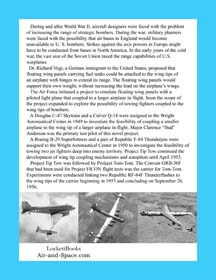Flying Aircraft Carriers of the USAF:
Wing Tip Coupling: B-29B/F-84D
|
Wright Air Development Center continued evaluating wing tip coupling with a Boeing B-29 Superfortress and a pair of Republic F-84D Thunderjets under the auspices of Project Tip Tow in 1950.
 Republic installed wing tip coupling lances on EF-84D Thunderjets 48-0641 and 48-0661. 48-0641 had a lance installed on its right wing tip and 48-0661 had a lance installed on its left wing tip. (Still frames from US Air Force film 18705 Range Extension of Bomber Escort)
Republic installed wing tip coupling lances on EF-84D Thunderjets 48-0641 and 48-0661. 48-0641 had a lance installed on its right wing tip and 48-0661 had a lance installed on its left wing tip. (Still frames from US Air Force film 18705 Range Extension of Bomber Escort)
 Lance on the wing tip of Thunderjet 48-0641. A retractable door hides the rear pitch lock. The rotation of the lance was coupled to the ailerons. As the Thunderjet rotated around the wing of the Superfortress, it was hoped that the ailerons would roll it back to wings level. It turned out that the ailerons were not strong enough for the task. (Still frame from Range Extension of Bomber Escort)
Lance on the wing tip of Thunderjet 48-0641. A retractable door hides the rear pitch lock. The rotation of the lance was coupled to the ailerons. As the Thunderjet rotated around the wing of the Superfortress, it was hoped that the ailerons would roll it back to wings level. It turned out that the ailerons were not strong enough for the task. (Still frame from Range Extension of Bomber Escort)
 The tip of the lance rotates to secure it into the receiver on the wing tip of the Superfortress. The rotation of the tip is triggered when the receiver makes contact with the button nect to the lance. (Still frame from Range Extension of Bomber Escort)
The tip of the lance rotates to secure it into the receiver on the wing tip of the Superfortress. The rotation of the tip is triggered when the receiver makes contact with the button nect to the lance. (Still frame from Range Extension of Bomber Escort)
 The receivers on the wing tipS of EB-29A 44-62093 were mounted on hydraulic booms that extended 19 inches from the tips. Flanges guided the aft pitch lock of the EF-84D to the pitch lock pin in the wing tip of the EB-29A.(Still frame from Range Extension of Bomber Escort)
The receivers on the wing tipS of EB-29A 44-62093 were mounted on hydraulic booms that extended 19 inches from the tips. Flanges guided the aft pitch lock of the EF-84D to the pitch lock pin in the wing tip of the EB-29A.(Still frame from Range Extension of Bomber Escort)
 Major Bud Anderson flew the Thunderjet on the right side. He coupled his Thunderjet to the wing tip of the Superfortress for the first time on July 20, 1950. (Still frame from Range Extension of Bomber Escort)
Major Bud Anderson flew the Thunderjet on the right side. He coupled his Thunderjet to the wing tip of the Superfortress for the first time on July 20, 1950. (Still frame from Range Extension of Bomber Escort)
 Captain John Davis flew theThunderjet on the left side. He coupled his EF-84D to the wing tip of the EB-29A for the first time on the fourth flight of the project on July 30, 1950.(Still frame from Range Extension of Bomber Escort)
Captain John Davis flew theThunderjet on the left side. He coupled his EF-84D to the wing tip of the EB-29A for the first time on the fourth flight of the project on July 30, 1950.(Still frame from Range Extension of Bomber Escort)
 Both Thunderjets coupled to the Superfortress together for the first tim on the ninth flight of the project on September 5, 1950. Note how the fixed ptich lock forced the EF-84Ds to fly banked toward the EB-29A. (Still frame from Range Extension of Bomber Escort)
Both Thunderjets coupled to the Superfortress together for the first tim on the ninth flight of the project on September 5, 1950. Note how the fixed ptich lock forced the EF-84Ds to fly banked toward the EB-29A. (Still frame from Range Extension of Bomber Escort)
 The contracted evaluation of the project concluded with the thirteenth flight on October 20, 1950. (Still frame from Range Extension of Bomber Escort)
The contracted evaluation of the project concluded with the thirteenth flight on October 20, 1950. (Still frame from Range Extension of Bomber Escort)
 Project Tip Tow continued through 1951 and 1952. Republic developed an electronic autopilot to keep the EF-84D level with the wing of the EB-29A and redesigned the wing tip coupling mechanism. (Still frame from Range Extension of Bomber Escort)
Project Tip Tow continued through 1951 and 1952. Republic developed an electronic autopilot to keep the EF-84D level with the wing of the EB-29A and redesigned the wing tip coupling mechanism. (Still frame from Range Extension of Bomber Escort)
 The electronic autopilot was ready for testing in March 1953. Cranes lifted the Thunderjets to the wing tips of the Superfortress for ground tests of the coupling mechanism.(Bud Anderson)
The electronic autopilot was ready for testing in March 1953. Cranes lifted the Thunderjets to the wing tips of the Superfortress for ground tests of the coupling mechanism.(Bud Anderson)
 The redesigned wing tip coupling mechanism provided electrical power to the Thunderjet so its engine, and the associated generators, could be shut down. Plug doors were installed in the EF-84D engine inlets to prevent windmilling of the jet turbine. (Bud Anderson)
The redesigned wing tip coupling mechanism provided electrical power to the Thunderjet so its engine, and the associated generators, could be shut down. Plug doors were installed in the EF-84D engine inlets to prevent windmilling of the jet turbine. (Bud Anderson)
 The coupling mechanism also transferred jet fuel and pressurized gas for the Thunderjet cockpit. (Bud Anderson)
The coupling mechanism also transferred jet fuel and pressurized gas for the Thunderjet cockpit. (Bud Anderson)
 Six test flights of the new coupling were flown in March and April 1953. The pitch lock pin in the wing tip of the EB-29A was adjustable to allow the EF-84D to be properly trimmed for wings level flight. (Bud Anderson)
Six test flights of the new coupling were flown in March and April 1953. The pitch lock pin in the wing tip of the EB-29A was adjustable to allow the EF-84D to be properly trimmed for wings level flight. (Bud Anderson)
 Bud Anderson's EF-84D, on the right wing tip, was fully instrumented. The other EF-84D had functional systems but lacked recording devices.(Bud Anderson)
Bud Anderson's EF-84D, on the right wing tip, was fully instrumented. The other EF-84D had functional systems but lacked recording devices.(Bud Anderson)
 Anderson's Thunderjet repeatedly failed to receive electrical power through the coupling. Eventually it was decided to do a functional test of the electronic autopilot with John Davis' Tthunderjet on April 24, 1953. (Bud Anderson)
Anderson's Thunderjet repeatedly failed to receive electrical power through the coupling. Eventually it was decided to do a functional test of the electronic autopilot with John Davis' Tthunderjet on April 24, 1953. (Bud Anderson)
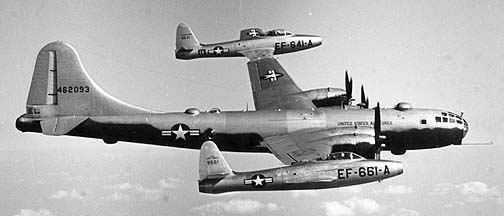 As Bud Anderson flew in formation on the right side of the Superfortress, John Davis brought the left-hand EF-84D into position and linked wingtips with the EB-29A. He transmitted, "Autopilot coming on" and then switched the autopilot on. It commanded hard nose-up elevator. Davis' Thunderjet rolled rapidly to the right onto the outer wing panel of the Superfortress. As the fighter rotated about the wing tip of the bomber, the explosive bolts fired to jettison the Thunderjet, but not in time to prevent the collision between the planes. The left wing of the EB-29A failed outboard of the engines. The nose of the EF-84D broke away from the rest of the airplane. (Bud Anderson)
As Bud Anderson flew in formation on the right side of the Superfortress, John Davis brought the left-hand EF-84D into position and linked wingtips with the EB-29A. He transmitted, "Autopilot coming on" and then switched the autopilot on. It commanded hard nose-up elevator. Davis' Thunderjet rolled rapidly to the right onto the outer wing panel of the Superfortress. As the fighter rotated about the wing tip of the bomber, the explosive bolts fired to jettison the Thunderjet, but not in time to prevent the collision between the planes. The left wing of the EB-29A failed outboard of the engines. The nose of the EF-84D broke away from the rest of the airplane. (Bud Anderson)
John Davis and five crew members aboard the EB-29A were killed in the accident. Wing tip coupling ecperiments continued as Project Tom-tom, using Convair JRB-36F 49-2707 and Republic RF-84F Thunderflashes 51-1848 and 51-1849 in 1955 and 1956.
 Bud Anderson is a WWII Triple Ace who flew the P-51 Mustang,
"Old Crow" while assigned to the 357th Fighter Group
"Yoxford Boys", 8th Air Force, Leiston Field, United
Kingdom. Visit the Clarence E.
"Bud" Anderson web site. I highly recommend buying
and reading a copy of his book, To Fly and Fight. It
contains his first person accounts of the early FICON test
flights.
Bud Anderson is a WWII Triple Ace who flew the P-51 Mustang,
"Old Crow" while assigned to the 357th Fighter Group
"Yoxford Boys", 8th Air Force, Leiston Field, United
Kingdom. Visit the Clarence E.
"Bud" Anderson web site. I highly recommend buying
and reading a copy of his book, To Fly and Fight. It
contains his first person accounts of the early FICON test
flights.
-advertisement -
- advertisement -
Wing Tip Coupling
2020 calendar
You can buy a 2020 calendar
featuring photographs of Air Force projects investigating the coupling of smaller airplanes to larger airplanes' wing tips.
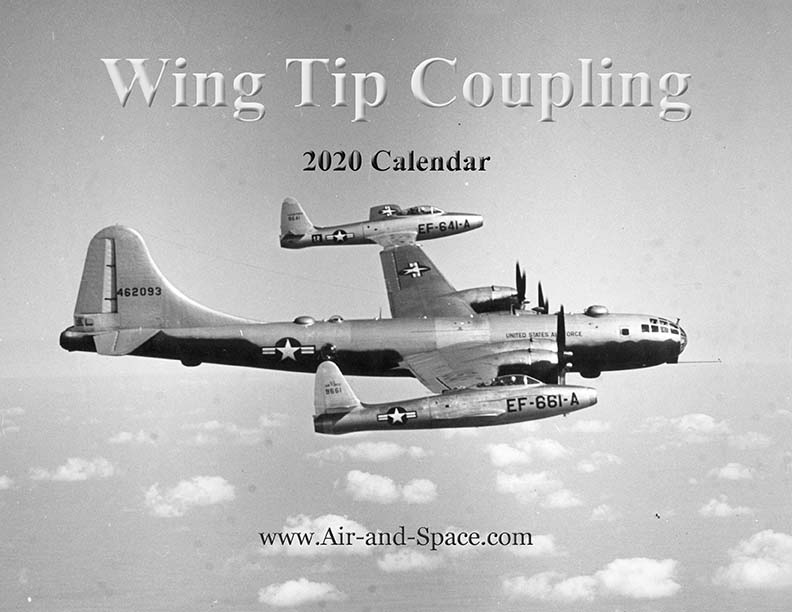
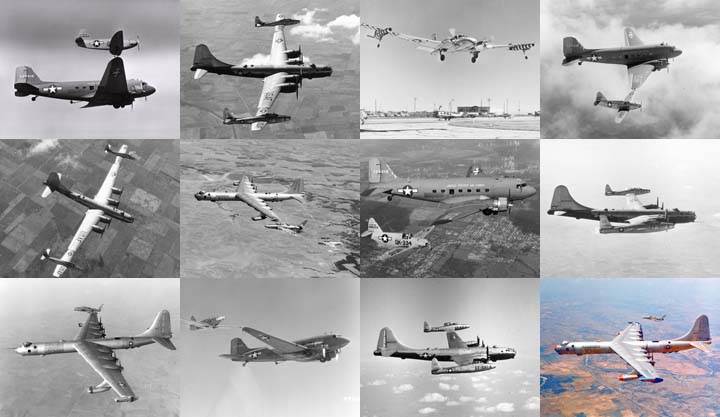
In the early years of the cold war, the US Air Force attempted to increase the range of airplanes by carrying fuel in hinged wing panels that supported themselves attached to their wing tips. The initial tests used a piloted light plane to simulate the hinged panels. Soon the scope of the experiments expanded to include towing a pair of jet fighters on the wing tips of a giant bomber. Photo sources: Bud Anderson, Air Force, General Dynamics, Lockheed-Martin:
Douglas C-47A 42-23918 and Culver Q-14B 44-68334
Project Tip-Tow: Boeing EB-29A 44-62093 and Republic EF-84D Thunderjets 48-0641 and 48-0661
Project Long Tom: Beechcraft XL-23C
Project Tom-Tom: Convair JRB-36F 49-2707 and Republic RF-84F Thunderflashes 51-1848 and 51-1849
 Put a copy of the Wing Tip Coupling: 2020 calendar in your Lulu.com shopping cart for $14.95.
Put a copy of the Wing Tip Coupling: 2020 calendar in your Lulu.com shopping cart for $14.95.
- advertisement -
Other Flying Aircraft Carriers of the USAF
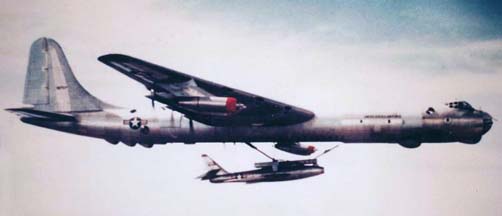 Flying Aircraft Carriers of the USAF
Flying Aircraft Carriers of the USAF
Go to the home page of the Goleta Air
and Space Museum. 
Send a message to Brian.
 Republic installed wing tip coupling lances on EF-84D Thunderjets 48-0641 and 48-0661. 48-0641 had a lance installed on its right wing tip and 48-0661 had a lance installed on its left wing tip. (Still frames from US Air Force film 18705 Range Extension of Bomber Escort)
Republic installed wing tip coupling lances on EF-84D Thunderjets 48-0641 and 48-0661. 48-0641 had a lance installed on its right wing tip and 48-0661 had a lance installed on its left wing tip. (Still frames from US Air Force film 18705 Range Extension of Bomber Escort)















 Bud Anderson is a WWII Triple Ace who flew the P-51 Mustang,
"Old Crow" while assigned to the 357th Fighter Group
"Yoxford Boys", 8th Air Force, Leiston Field, United
Kingdom. Visit the Clarence E.
"Bud" Anderson web site. I highly recommend buying
and reading a copy of his book, To Fly and Fight. It
contains his first person accounts of the early FICON test
flights.
Bud Anderson is a WWII Triple Ace who flew the P-51 Mustang,
"Old Crow" while assigned to the 357th Fighter Group
"Yoxford Boys", 8th Air Force, Leiston Field, United
Kingdom. Visit the Clarence E.
"Bud" Anderson web site. I highly recommend buying
and reading a copy of his book, To Fly and Fight. It
contains his first person accounts of the early FICON test
flights. 
